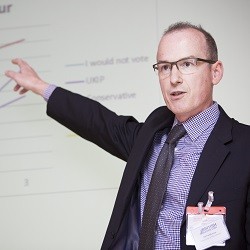There has been a lot of speculation about the turnout of young voters in tomorrow’s General Election. In 2010 only an estimated 44% of the under 25s voted compared to 65% overall. But with a close run and unpredictable election turnout may well be higher this time around. With Russell Brand recently endorsing voting, is it likely that there will be a bounce in turnout amongst the youngest cohort of electors. We modelled the 2010 probability of voting in 2010 using the pre and post-election waves of the 2010 British Election Survey when the vote was validated (in other words. it was verified whether BES respondents voted or not by checking sample against the public records of turnout). This provided a probability of voting for every respondent t in 2010 according to their age, reported likelihood of voting before the election, whether they had voted in in the previous election (2005) and the turnout in the parliamentary constituency in 2010. These probabilities were then applied to voters in BES 2015 wave 4, matched by these same characteristics. This gives an estimated turnout likelihood of our respondents in 2015 (these estimates were also used in our BES forecast blog) This estimate is still much higher than you would expect (averaging at 78%) simply because survey respondents are generally more likely to vote than the general public – in other words we have adjusted for mis-reporting (though the model) but not for the oversampling of voters.
Notwithstanding this our predicted probabilities give a fair picture of the differences between age groups (see the chart below, blue bars). To help compensate for the over-sampling of voters we can also compare the average predicted level for the sample in 2010 (which was 69%) with the actual level of turnout (65%). In other words even when we use verified vote, the over-sampling of voters meant that actual turnout was 69% in the BES compared to 65% in the electorate as a whole. Since the sample predicted rate is now 78% compared to only 69% in 2010 we might reasonably expect to see a raise in turnout. In other words the predicted sample turnout is up from 68% to 78%, so we might expect actual turnout to also increase. To rescale our estimates to reflect this, we can rescale the age specific figures to fit an average level of (a fairly arbitrary) 70%. The rescaled figures are show in red bars. Of course we have to be a little careful about the rescaling because (a) we do not know the extent of bias in the sample in 2015 compared to 2010 and (b) because it is quite likely that the under-representation of non-voters in the sample is highest in the groups least likely to turnout (so the relative differences may be rather greater than the red bars suggest). Nevertheless the chart does suggest we might see a recovery of turnout amongst younger voters on May 7th.


